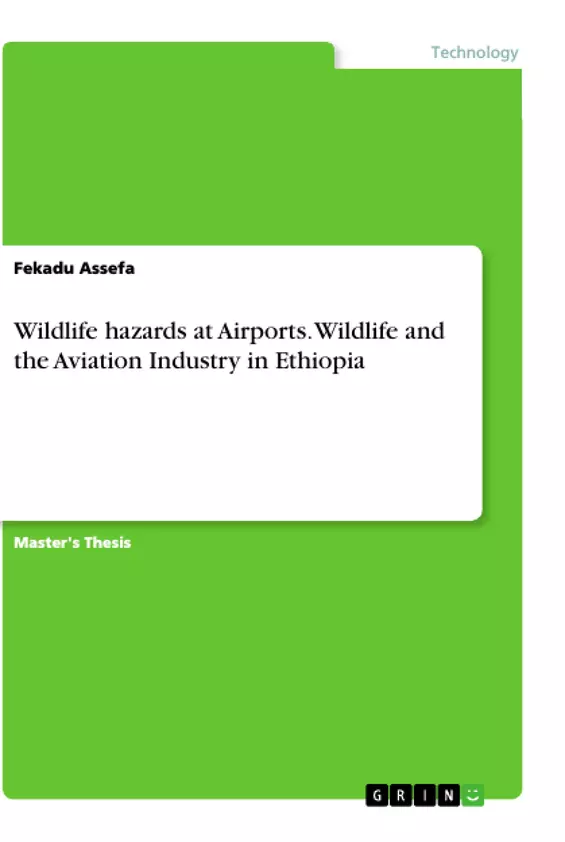The study aimed to assess the effects of wildlife hazards at Bole International Airport, Addis Ababa, Ethiopia. Monitoring wildlife numbers and other wild animals, activity pattern and abundance within the study area generates a complimentary source of data, which is more suited for developing efficient hazard management mechanisms.
Different wildlife’s commonly causes damage to aviation industry around the world. The study findings recorded about 70 species of wildlife including plants during the study period. The study results illustrated that some of the wildlife animals either living in or visiting the airport have often caused threats to aircraft operation in the airport directly or indirectly. Only between 2014 and 2018, 416 strikes were reported at the airport. The total amount of cost due to wildlife strike for the last six years was estimated at 4, 768,310.00 USD. Thus, it is recommended that Addis Ababa Bole International Airport should establish proactive systematic approach to deal with wildlife hazard than reactive or traditional approach.
Inhaltsverzeichnis (Table of Contents)
- Chapter One. Introduction
- 1.1Background
- 1.2. Statement of the problem
- 1.3 Objective of the study.
- 1.4 Research question
- 1.5 Scope of the study.
- 1.6 Significance of the study
- 1.7 Limitation of the study....
- 1.8 Definition of terms..........\li>
- 1.9 Organization of the thesis.
- Chapter Two. Related Literature Review.
- 2.1 Theory of Airports wildlife strikes/accidents.
- 2.1.1 Direct and Indirect cost of wildlife strike.
- 2.1.2 Wildlife appealing features at aerodrome.....
- 2.1.3 Wildlife accident on aircraft………………………………..\li>
- 2.2 Airport Wildlife hazard management system.
- 2.2.1World Wildlife Strike Association
- 2.2.2Ethiopian wildlife hazard management legal frame work......
- 2.3 Conceptual framework
- Chapter Three. The study area
- 3.1 Description of the study area…........
- 3.2 Topography.
- 3.2.1 Climate
- 3.2.2 Temperature
- 3.2.3 Clouds.......
- 3.2.4Rainfall
- 3.2.5 Sun
- Chapter Four. Methodology
- 4.1 Research design
- 4.2 Research approach, data sources and methods of data collection..\n.21
- 4.3 Tools and Technique of primary data source
- 4.4 Field Observation
- 4.5 Focus group discussions (FGDs)..\li>
- 4.6 Key Informant Interview (KII)..\li>
- 4.7 Secondary data source..\li>
- 4.8 Sampling techniques.......
- 4.9 Method of data analysis
- 4.10 Data validity and reliability.
- Chapter Five: Results and Discussion.
- 5.1 Results..........\li>
- 5.1.1 Wildlife Observed in Addis Ababa Bole international airport...
- 5.1.2 Wildlife attractants inside Addis Ababa Bole international airport..........\li>
- Grass and vegetation.
- Water
- Food source.....
- Open Terrain..\li>
- Buildings and Structures
- Landscaping...\li>
- 5.1.3 Addis Ababa Bole international airport wildlife strike........
- Wildlife strike vs aircraft type at AABIA (2014-2019)\n.44
- Wildlife strike vs Number of flights……………………………….\li>
- Total wildlife strike vs weather at AABIA.\li>
- 5.1.4 The Effect of wildlife hazard on aircraft at Addis Ababa Bole international airport.
- 5.2 Discussion..........\li>
- 5.2.1 Wildlife strike at AABIA
- 5.2.2 Diversity of wildlife in the Airport.
Zielsetzung und Themenschwerpunkte (Objectives and Key Themes)
This study explores the impact of wildlife hazards on aircraft operations at Bole International Airport in Addis Ababa, Ethiopia. The research aims to analyze the types of wildlife present at the airport, identify the factors attracting them to the area, and assess the frequency and impact of wildlife strikes on aircraft. The study also examines the existing wildlife hazard management systems and recommends strategies for improving them. Here are the key themes:- Wildlife diversity and distribution at Bole International Airport
- Factors attracting wildlife to the airport
- The frequency and impact of wildlife strikes on aircraft
- The existing wildlife hazard management system at the airport
- Recommendations for improving wildlife hazard management
Zusammenfassung der Kapitel (Chapter Summaries)
- Chapter One: This chapter sets the stage by introducing the topic of wildlife hazard to aviation at Bole International Airport. It defines the problem, outlines the research objectives and questions, and describes the scope and significance of the study. The chapter also outlines the study's limitations and provides definitions for key terms.
- Chapter Two: This chapter explores existing literature on wildlife strikes at airports. It examines the theoretical framework behind such incidents, focusing on the direct and indirect costs associated with strikes. The chapter also delves into the features that make airports attractive to wildlife and investigates the impact of wildlife incidents on aircraft safety. Finally, it examines existing wildlife hazard management systems both globally and in Ethiopia.
- Chapter Three: This chapter provides an overview of the study area, Bole International Airport, including its topography, climate, temperature, cloud cover, rainfall patterns, and sunlight exposure. This contextual information is essential for understanding the potential for wildlife presence at the airport.
- Chapter Four: This chapter outlines the research methodology employed in the study. It describes the research design, data sources, and methods of data collection. This includes a detailed explanation of the tools and techniques used to gather primary data, such as field observations, focus group discussions, key informant interviews, and secondary data sources. The chapter also outlines the sampling techniques used and explains how data was analyzed, focusing on the validity and reliability of the findings.
- Chapter Five: This chapter presents the results of the study, including the identification of wildlife species observed at Bole International Airport, the factors attracting wildlife to the airport, the frequency and impact of wildlife strikes, and an analysis of the existing wildlife hazard management systems at the airport.
Schlüsselwörter (Keywords)
The study centers around the intersection of aviation, wildlife, and environmental safety. Key terms include wildlife hazard, wildlife strike, aviation safety, airport management, wildlife management, Bole International Airport, Addis Ababa, Ethiopia, and biodiversity.- Quote paper
- Fekadu Assefa (Author), 2020, Wildlife hazards at Airports. Wildlife and the Aviation Industry in Ethiopia, Munich, GRIN Verlag, https://www.grin.com/document/935692



